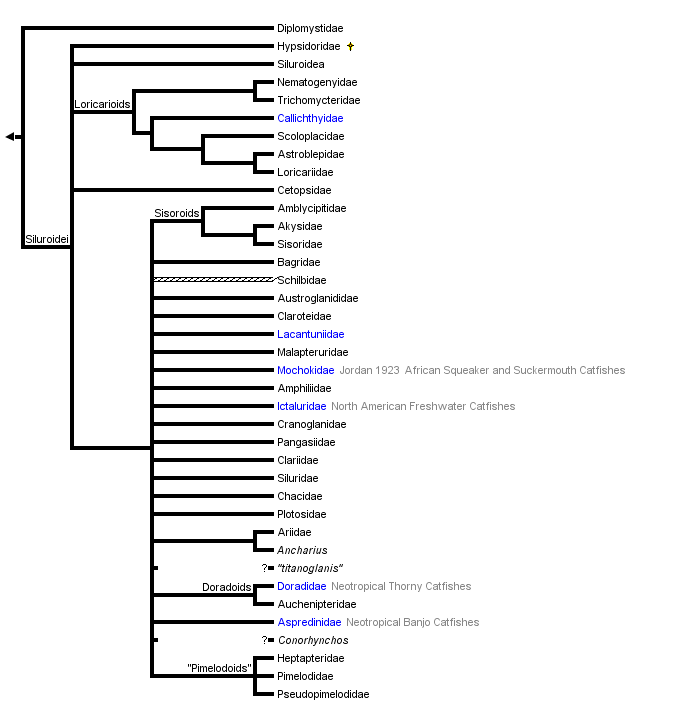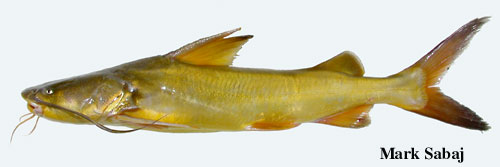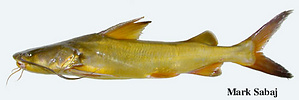Siluriformes
Catfishes
John G. Lundberg and John P. Friel


This tree diagram shows the relationships between several groups of organisms.
The root of the current tree connects the organisms featured in this tree to their containing group and the rest of the Tree of Life. The basal branching point in the tree represents the ancestor of the other groups in the tree. This ancestor diversified over time into several descendent subgroups, which are represented as internal nodes and terminal taxa to the right.

You can click on the root to travel down the Tree of Life all the way to the root of all Life, and you can click on the names of descendent subgroups to travel up the Tree of Life all the way to individual species.
For more information on ToL tree formatting, please see Interpreting the Tree or Classification. To learn more about phylogenetic trees, please visit our Phylogenetic Biology pages.
close boxIntroduction
Catfishes are a species rich and exceptionally diverse group of fishes ranking second or third among orders of vertebrates. The Catalog of Fishes (Eschmeyer, 1998 et seq.) database treats 2,855 species of catfishes as valid. About 1 in 4 valid species of freshwater fishes, 1 in 10 fishes, and 1 in 20 vertebrates, is a catfish.
Although most catfishes are of small to moderate size (5-20 cm), some aspredinids and trichomycterids are among the smallest vertebrates in the world, reaching sexual maturity at less than 10 mm in total length. Others are among the largest freshwater fishes in the world: Silurus glanis (European wels, to 5 m, 330 kg, the largest of catfishes), Pangasianodon gigas (giant Mekong catfish, to 3 m, 300 kg), and Brachyplatystoma filamentosum (Amazonian goliath catfish, to 3+ m, 200 kg).
Most catfishes are omnivores, but some have highly specialized diets, e.g., wood-eating loricariids (Nelson, et al., 1999) and parasitic catfishes that feed on the blood of other fishes (de Pinna, 1992; Spotte, 2002). Most catfishes have defensive fin spines that can inflict severe wounds. Species in several families are venomous. Like their close gymnotiform relatives, many catfishes are electroreceptive (Baron, et al., 1996a,b). Species in the genus Malapterurus are capable of generating charges of 400 volts or more (Burgess, 1989). Unlike most freshwater fishes, many catfishes are nocturnal and depend mainly on senses other than sight, such as tactile and chemosensitive barbels, or enlarged olfactory organs. Thus, catfishes are preadapted for life in caves, aquifers, and deep river channels, and troglobitic catfishes have evolved in North and South America, Asia, and Africa. Air-breathing clariid catfishes regularly leave the water and move over land (Burgess, 1989). Several groups of catfishes communicate acoustically; some by vibrating the swim bladder, others by stridulatory fin spines. Most species of catfishes provide parental care to eggs; some also provide care to young. In an interesting symbiotic relationship, certain African bagrids also protect the young of cichlids (McKaye & Oliver, 1980). Most families of catfishes including basal diplomystids and their closest otophysan relatives are strictly freshwater. Consequently, the marine habitat of Plotosidae, Ariidae and some Aspredinidae is considered derived for catfishes.
Because of their worldwide distribution and diversity, catfishes are of great interest to ecologists and evolutionary biologists, and are important in studies of biogeography - from regional, e.g. post-glacial North America (Bailey and Smith, 1981) and Southeast Asia (Bornbusch and Lundberg, 1989), to continental - e.g. North America (Patterson, 1981, Grande, 1994) and South America (Reis, 1998; Lundberg, 1997), to global (de Pinna, 1993, 1998; Lundberg, 1993). Catfishes are most diverse in species and morphology in tropical South America, Africa, and Asia. However, catfishes live or have lived in the inland or coastal waters of all continents, including Antarctica, where fossils of Eocene age are found on Seymour Island (Grande and Eastman, 1986). The earliest known fossil siluriforms are in freshwater and marine deposits of late Cretaceous (Campanian and Maastrichtian) age.
Many catfishes around the world have huge economic value and are fished for human consumption, the pet trade, or recreation. Worldwide capture production of freshwater and marine catfishes in 2000 exceeded 500,000 mt (FAO Yearbook of Fishery Statistics 2000a). The North American channel catfish (Ictalurus punctatus) supports a $450 million/yr aquaculture industry (FAO Yearbook of Fishery Statistics 2000b). The South American, armored "corydoras" and "plecostomus" catfishes are icons of the aquarium trade. Several catfishes (e.g. the flathead catfish in North America, goliath catfishes in South America) are aggressively sought by big game anglers. Conversely, translocated species cause substantial economic loss and damage to natural ecosystems and native fish stocks. Significant catfish pests in North America include the walking catfish, Clarias batrachus, in Florida, and the flathead catfish, Pylodictis olivaris, in Atlantic slope drainages (Fuller, et al., 1999).
Discussion of Phylogenetic Relationships
Siluriformes is clearly monophyletic as indicated by several complex anatomical synapomorphies (Fink & Fink, 1981, 1996) including modification of the upper jaw to support and move a pair of sensory barbels, and locking fin spines.
Approximately 436 genera and over 30 families of catfishes are recognized. Although there is general agreement on the broad outline of the higher level phylogeny of catfishes many questions remain. The southern South American Diplomystidae are the plesiomorphic sister group of the remaining catfishes or Siluroidei (Grande, 1987). Within the Siluroidei, the middle Eocene Hypsidoris (Hypsidoridae) from North America is the primitive sister taxon of all other catfishes or Siluroidea (Grande, 1987).
Two of the largest nominal families, the South American Pimelodidae and the African-Asian Bagridae have been vaguely portrayed as the "ancestral" groups for the Old World and Neotropical catfish radiations. It is possible or likely that the pimelodids and bagrids are paraphyletic (Mo, 1991; Pinna, 1993), although within each family monophyletic subgroups have been diagnosed (Mo, 1991; Pinna, 1993; Lundberg et al. 1991; Bailey and Stewart, 1984).
References
Bailey, R.M., and G.R. Smith. 1981. Origin and geography of the fish fauna of the Laurentian Great Lakesbasin. Canadian J. Fish Aquat. Sci. 38:1539-1561.
Bailey, R. M. and D. J. Stewart. 1984. Bagrid catfishes from Lake Tanganyika, with a key and descriptions of new taxa. Misc. Publ. Mus. Zool., Univ. Michigan 168:1-41.
Baron, V.D., A.A. Orlov, and A.S. Golubtsov. 1996a. African catfishes. A new group of weakly electric fish. Izvestiya RAN. Ser. Biol., (1): 106-111. (in Russian)
Baron, V. D., A. A. Orlov, and A. S. Golubtsov. 1996b. Discovery of electric discharges in the African catfish Auchenoglanis occidentalis (Siluriformes: Bagridae). Dokl. Akad. Nauk, 349 (4): 565-567. (in Russian)
Baskin, J.N. 1973. Structure and relationships of the Trichomycteridae. Unpublished Ph.D. Dissertation, City University of New York, New York. 389 p.
Bornbusch, A.H., and J.G. Lundberg. 1989. A new species of Hemisilurus (Siluriformes, Siluridae) from the Mekong River, with comments on its relationships and historical biogeography. Copeia, 1989:434-444.
Burgess, W.E. 1989. An atlas of freshwater and marine catfishes. A preliminary survey of the Siluriformes. T.F.H. Publications, Neptune City, New Jersey.784 p, 285 pl.
Chen, X., and J.G. Lundberg. 1995. Xiurenbagrus, a new genus of amblycipitid catfishes (Teleostei: Siluriformes), and phylogenetic relationships among the genera of Amblycipitidae. Copeia, 1995 (4): 780-800.
Eschmeyer, W.E. (ed.) 1998. Catalog of Fishes. California Academy of Sciences, San Francisco.
FAO Yearbook of Fishery Statistics 2000a. Capture production. Vol. 90/1. Rome, FAO. 2002. 617p.
FAO Yearbook of Fishery Statistics 2000b. Aquaculture production. Vol. 90/2. Rome, FAO. 2002. 178p.
Ferraris, C.J. Jr. 1988. The Auchenipteridae: putative monophyly and systematics, with a classification of the Neotropical doradoid catfishes (Ostariophysi, Siluriformes). Unpublished Ph.D. Dissertation, City University of New York, New York, xvi + 229 p.
Ferraris, C.J. Jr., and R.P. Vari. 1999. The South American catfish genus Auchenipterus Valenciennes, 1840 (Ostariophysi: Siluriformes: Auchenipteridae): monophyly and relationships, with a revisionary study. Zoological Journal of the Linnean Society 126 (4): 387-450.
Fink, S.V., and W.L. Fink. 1981. Interrelationships of the ostariophysan fishes (Teleostei). Journal of the Linnean Society (Zoology), 72(4): 297-353.
Fink, S.V., and W.L. Fink. 1996. Interrelationships of the ostariophysan fishes (Teleostei). pp. 209-250. In M.L.J. Stiassny, L.R. Parenti and G.D. Johnson (eds.). Interrelationships of fishes. Academic Press, San Diego.
Friel, J. P. 1994. A Phylogenetic Study of the Neotropical Banjo Catfishes (Teleostei: Siluriformes: Aspredinidae. Unpublished Ph.D thesis, Duke University, 256 pp.
Fuller, P.L., L.G. Nico, and J.D. Williams. 1999. Nonindigenous fishes introduced into inland waters of the United States. American Fisheries Society, Special Publication No. 27. Bethesda, MD. 613 pp.
Grande, L. 1987. Redescription of Hypsidoris farsonensis (Teleostei: Siluriformes), with a reassessment of its phylogenetic relationships. Journal of Vertebrate Paleontology 7:24-54.
Grande, L. 1994. Studies of paleoenvironments and historical biogeography in the Fossil Butte and Laney Members of the Green River Formation. Univ. Wyoming Contrib. Geol. 30:15-32.
Grande, L., and J. T. Eastman. 1986. A review of the Antarctic ichthyofaunas in light of new fossil discoveries. Paleontology, 29:113-137.
Hardman, M. 2002. The phylogenetic relationships among extant catfishes, with special reference to Ictaluridae (Otophysi: Siluriformes). Unpubl. Ph.D Dissertation, University of Illinois, Champaign, Illinois. 228 p.
Lundberg, J.G. 1993. African-South American freshwater fish clades and continental drift: Problems with a paradigm. pp.156-199. In P. Goldblatt, (ed.) Biological relationships between Africa and South America. Yale Univ. Press, New Haven.
Lundberg, J.G. 1997. Fishes of the La Venta fauna: additional taxa, biotic and paleoenvironmental implications. pp. 67-91. In R. F. Kay et al. (eds.) Vertebrate paleontology in the Neotropics: The Miocene fauna of La Venta Colombia. Smithsonian Institution Press, Washington, D.C.
Lundberg, J.G. 1998. The temporal context for diversification of Neotropical fishes. Chapter 2. In L.R. Malabarba, R.E. Reis, R.P. Vari, C.A.S. Lucena and Z.M.S. Lucena (eds.), Phylogeny and classification of Neotropical fishes. EDIPUCRS. Porto Alegre, Brazil.
Lundberg, J.G., and L. McDade. 1986. A redescription of the rare Venezuelan catfish Brachyrhamdia imitator Myers (Siluriformes: Pimelodidae) with phylogenetic evidence for a large intrafamilial lineage. Notula Naturae, (463):1-24.
Lundberg, J.G., A.H. Bornbusch, and F. Mago-Leccia. 1991. Gladioglanis conquistador n. sp. from Ecuador, with diagnoses of the subfamily Rhamdiinae Bleeker (1862) and Pseudopimelodinae n.subf. (Siluriformes:Pimelodidae). Copeia, 1991 (1): 190-208.
Lundberg, J.G., F. Mago-Leccia, and P. Nass. 1991. Exallodontus aguanai, a new genus and species of Pimelodidae (Teleostei: Siluriformes) from deep river channels of South America and delimitation of the sub-family Pimelodinae. Proceedings of the Biological Society Washington. 104(4):840-869.
Lundberg, J.G., M. Kottelat, G.R. Smith, M. Stiassny, and T. Gill. 2000. So many fishes, so little time: An overview of recent ichthyological discoveries in fresh waters. Ann. Missouri Bot. Gard. 87(1): 26-62.
Lundberg, J.G., and R. Troll. 2001. Freshwater Riches of the Amazon. Natural History Magazine, American Museum of Natural History, 111 (7, for September): 36-42.
McKaye, K.R., and M.K. Oliver. 1980. Geometry of a selfish school: Defence of cichlid young by bagrid catfish in Lake Malawi, Africa. Animal Behaviour, 28:1287-1290.
Mo, T. 1991. Anatomy, relationships and systematics of the Bagridae (Teleostei: Siluroidei) with a hypothesis of siluroid phylogeny. Theses Zoologicae 17, Koeltz Scientific Books, Koenigstein, vii + 216pp., 63 figs.
Montoya-Burgos, J., S. Muller, C. Weber, and J. Pawlowski. 1997. Phylogenetic relationships between Hypostominae and Ancistrinae (Siluroidei: Loricariidae): first results from mitochondrial 12S and 16S rRNA gene sequences. Rev. Suisse Zool., 104 (1): 185-198.
Nelson, J.A., M.E. Whitmer, E.A. Johnson, D. Wubah, and D.J. Stewart. 1999. Wood-eating catfishes of the genus Panaque (Eigenmann & Eigenmann): gut microflora and enzyme activities. J. Fish Biol., 54: 1069-1082.
Nelson, J.S. 1994. Fishes of the world, 3rd edition. John Wiley & Sons, New York.
Norris, S.M. 2002. A revision of the African electric catfishes, family Malapteruridae (Teleostei, Siluriformes), with erection of a new genus and descriptions of fourteen new species, and an annotated bibliography. Ann. Mus. R. Afr. Cent. Ser. in 8º, Zool., No. 289.
Patterson, C. 1981. The development of the North American fish fauna -- problem of historical biogeography. Pp. 265-281. In P. L. Forey (ed.), The Evolving Biosphere. Cambridge Univ. Press, Cambridge, England.
de Pinna, M.C.C. 1992. A new subfamily of Trichomycteridae (Teleostei, Siluriformes), lower loricarioid relationships and a discussion on the impact of additional taxa for phylogenetic analysis. Zool. J.Linn. Soc., 106 (3): 175-229.
de Pinna, M.C.C. 1993. Higher-level phylogeny of Siluriformes (Teleostei, Ostariophysi), with a new classification of the order. Unpubl. Ph.D Dissertation, City Univ. of New York, New York. 482 p.
de Pinna, M.C.C. 1996. A phylogenetic analysis of the Asian catfish families Sisoridae, Akysidae, and Amblycipitidae, with a hypothesis on the relationships of the neotropical Aspredinidae (Teleostei, Ostariophysi). Fieldiana Zool. (N. S.), No. 84: i-iv + 1-83.
de Pinna, M.C.C. 1998. Phylogenetic relationships of neotropical Siluriformes (Teleostei: Ostariophysi): historical overview and synthesis of hypotheses. Pp. 279-330. In L. R. Malabarba, R. E. Reis R. P. Vari, Z. M. Lucena, and C.A.S. Lucena (eds.), Phylogeny and classification of Neotropical fishes. EDIPUCRS, Porto Alegre.
de Pinna, M.C.C. and R.P. Vari. 1995. Monophyly and phylogenetic diagnosis of the family Cetopsidae, with synonymization of the Helogenidae (Teleostei: Siluriformes). Smithsonian Contrib. Zool., No. 571: i-iii + 1-26.
Reis, R.E. 1998. Systematics, biogeography, and the fossil record of the Callichthyidae: a review of the available data. Pp. 351-362. in L.R. Malabarba, R. E. Reis R. P. Vari, Z.M. Lucena, and C.A.S. Lucena (eds.), Phylogeny and classification of Neotropical fishes. EDIPUCRS, Porto Alegre. 1-603.
Retzer, M.E., and L.M. Page. 1997. Systematics of the stick catfishes, Farlowella (Pisces, Loricariidae). Proceedings of the Academy of Natural Sciences of Philadelphia, 147:33-88.
Roberts, T.R., and C.J. Ferraris, Jr. 1998. Review of South Asian sisorid catfish genera Gagata and Nangra, with descriptions of a new genus and five new species. Proc. California Acad. Sci., 50 (14): 315-345.
Rodiles Hernandez, R., D. Hendrickson, J.G. Lundberg, and J. Alves Gomes. 2000. A new siluriform family from southern Mexico. Abstracts, annual meeting of the American Society of Ichthyologists & Herpetologists, La Paz, Mexico.
Royero, R. 1987. Morfologia de la aleta dorsal en los bagres (Teleoste: Siluriformes), con especial referencia a las familias americanas. Unpublished bachelor’s Dissertation, Universidad Central de Venezuela, Facultad de Ciencias, Escuela de Biologia, Caracas, 232p.
Sabaj, M.H. 2002. Taxonomy of the neotropical thorny catfishes (Siluriformes: Doradidae) and revision of genus Leptodoras. Unpublished Ph.D. Dissertation. University of Illinois, Champaign, Illinois. 412p.
Schaefer S.A. 1990. Anatomy and relationships of the scoloplacid catfishes. Proceedings of the Academy of Natural Sciences of Philadelphia, 142:167-210.
Spotte, S. 2002. Candiru: Life and legend of the bloodsucking catfishes. Creative Arts Books, Berkeley.
Title Illustrations

| Scientific Name | Arius parkeri |
|---|---|
| Location | Guyana |
| Comments | Specimen showing fin spines, barbels and naked skin characteristic of most catfishes. |
| Specimen Condition | Dead Specimen |
| Image Use |
 This media file is licensed under the Creative Commons Attribution-NonCommercial-ShareAlike License - Version 3.0. This media file is licensed under the Creative Commons Attribution-NonCommercial-ShareAlike License - Version 3.0.
|
| Copyright |
© 2002 Mark Henry Sabaj

|
About This Page
John G. Lundberg

The Academy of Natural Sciences, Philadelphia, Pennsylvania, USA
John P. Friel

Cornell University Museum of Vertebrates, Ithaca, New York, USA
Page copyright © 2003 John G. Lundberg and John P. Friel
 Page: Tree of Life
Siluriformes. Catfishes.
Authored by
John G. Lundberg and John P. Friel.
The TEXT of this page is licensed under the
Creative Commons Attribution-NonCommercial-ShareAlike License - Version 3.0. Note that images and other media
featured on this page are each governed by their own license, and they may or may not be available
for reuse. Click on an image or a media link to access the media data window, which provides the
relevant licensing information. For the general terms and conditions of ToL material reuse and
redistribution, please see the Tree of Life Copyright
Policies.
Page: Tree of Life
Siluriformes. Catfishes.
Authored by
John G. Lundberg and John P. Friel.
The TEXT of this page is licensed under the
Creative Commons Attribution-NonCommercial-ShareAlike License - Version 3.0. Note that images and other media
featured on this page are each governed by their own license, and they may or may not be available
for reuse. Click on an image or a media link to access the media data window, which provides the
relevant licensing information. For the general terms and conditions of ToL material reuse and
redistribution, please see the Tree of Life Copyright
Policies.
- First online 04 July 1995
- Content changed 20 January 2003
Citing this page:
Lundberg, John G. and John P. Friel. 2003. Siluriformes. Catfishes. Version 20 January 2003 (under construction). http://tolweb.org/Siluriformes/15065/2003.01.20 in The Tree of Life Web Project, http://tolweb.org/







 Go to quick links
Go to quick search
Go to navigation for this section of the ToL site
Go to detailed links for the ToL site
Go to quick links
Go to quick search
Go to navigation for this section of the ToL site
Go to detailed links for the ToL site